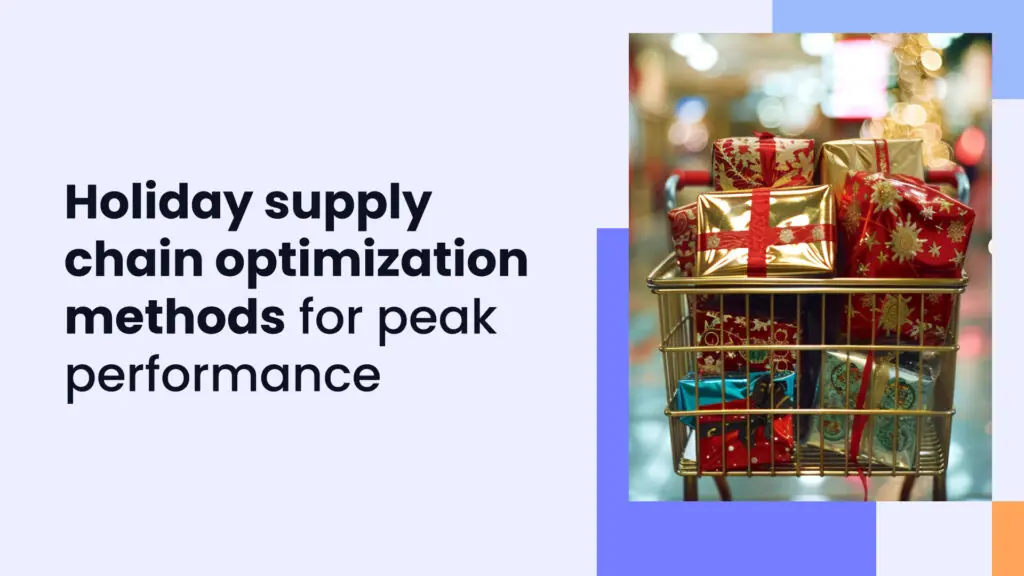The holiday season is, without a doubt, the most lucrative period for eCommerce businesses. In fact, US holiday retail sales reached a staggering $936.3 billion in 2022, marking a 5.3% growth from the previous year. Online sales alone saw an impressive increase, contributing $261.6 billion to this total.
Globally, eCommerce sales during the holiday season are projected to continue growing, with forecasts suggesting a 12% rise in the upcoming years. For many online sellers, this is the make-or-break time to secure significant revenue and boost profits.
With so much money in play, the pressure is on to meet the skyrocketing demand while ensuring smooth operations. Supply chain disruptions, stockouts, and logistical bottlenecks can lead to missed opportunities and dissatisfied customers. As Black Friday, BFCM (Black Friday Cyber Monday), and the rest of Q4 approach, with the right strategies in place, your supply chain can be the key to not only surviving but thriving during this high-demand period.
In this article, we’ll present actionable tips to help you optimize your supply chain for the holiday season, avoid common pitfalls, and turn these busy months into a lasting business win.
Key areas to focus on for holiday supply chain optimization
So what are the top factors to consider if you want to optimize your supply chain for the holiday season? We’ve listed 4 elements we believe you should center on:
Forecasting demand
As we’ve seen with DAVAN, accurate demand forecasting is crucial for ensuring you have the right amount of stock on hand during the holiday season. By analyzing past sales trends from previous holiday periods, you can gain insights into customer behavior and buying patterns.
However, with fluctuating market conditions, it’s essential to integrate data-driven tools such as AI-powered forecasting software to account for real-time data, and external factors like economic conditions, marketing efforts, and competitor pricing.
These advanced tools can reduce forecasting errors and ensure that you’re well-prepared to meet customer demand without overstocking or facing stockouts.
Subscribe to the eCommerce newsletter for
top industry insights
Building buffer stock
One of the biggest risks during the holiday season (and also in general) is running out of stock. Building a buffer, or safety stock, helps protect your business against sudden demand surges or supply chain delays.
This extra inventory acts as a cushion to ensure that you can continue fulfilling orders even when facing unexpected disruptions. However, balancing buffer stock with warehouse capacity is crucial. Overloading your warehouse can lead to inefficiencies, while not having enough buffer stock increases the risk of stockouts.
That is exactly why properly planning your buffer stock – based on demand forecasts – can ensure a smooth and efficient supply chain during peak times.
Flexible shipping and delivery solutions
The holiday season often comes with logistical challenges like carrier delays, increased shipping costs, and overwhelmed couriers. To combat this, diversifying your shipping options by partnering with multiple carriers can offer more flexibility and relief during the busy season.
Expedited delivery options can also reduce delays and increase customer satisfaction, especially when last-minute holiday shopping spikes.
By working with a range of shipping partners, you can reduce bottlenecks, ensure timely deliveries, and prevent fulfillment issues. Offering customers real-time tracking can further enhance their trust in your brand and minimize concerns about delivery delays.
Automated inventory management
Automation can make all the difference during a busy holiday season. AI-driven inventory management tools allow you to automate stock level updates, ensuring that you’re always aware of which products are running low. These systems can also alert you to potential bottlenecks or delays before they become pressing issues, allowing you to act proactively.
Automation doesn’t just help with inventory – it can improve decision-making by offering real-time data on your supply chain operations, giving you the time to focus on meeting demand and growing your business.
| Metrics | Manual inventory management | Automated inventory management |
|---|---|---|
| Error rates | High error rates due to manual entry | Low error rates with automated processes |
| Response times | Slow response times due to human involvement | Fast response times with real-time tracking |
| Scalability | Limited scalability; difficult to handle surge during BFCM | Highly scalable to meet increased demand during BFCM |
| Adaptability to BFCM demand | Requires significant adjustment; not flexible | Adapts easily to fluctuations in demand |
| Real-time stock updates | Not real-time; prone to delays | Real-time stock updates with AI-driven tools |
| Cost-effectiveness | Low initial cost but high in inefficiencies over time | Higher initial cost but saves money by improving efficiency |
Strategies for dealing with suppliers and vendors
Working with suppliers and vendors during the holiday season can be tricky. With rising demand and tighter deadlines, staying on top of communication and planning becomes more crucial than ever.
To help keep things running smoothly, we’ve outlined a few strategies that will make dealing with your suppliers a breeze:
Open communication with suppliers
Clear communication with your suppliers is key year-round, but it’s especially so during the holiday rush. By sharing your demand forecasts with them, you give them the time and data they need to prepare for the increase in orders.
Keeping an open line of communication ensures that if there are any issues or delays, they can be addressed promptly before they become major problems. It’s always good to stay connected, but it becomes imperative during these times.
Diversifying suppliers
As mentioned previously, it may not be effective to rely on a single supplier, as it can leave your business vulnerable to disruptions – especially if they experience delays or shortages. To safeguard your supply chain, it’s wise to diversify your supplier base.
Working with multiple suppliers reduces your risk and provides more flexibility to adjust if one supplier can’t meet your demands.
Negotiating lead terms
During the holiday season, lead times often become longer due to high demand, making the whole supply chain process more difficult and more excruciating. Negotiating lead times with your suppliers early on can help secure priority in production and shipping.
This way, you can avoid costly delays and ensure that your inventory is well-stocked when it matters most.
One of the best ways to secure faster production and shipping from your suppliers is by having the financial flexibility to place larger orders upfront or expedite processes.
Securing additional funding through flexible growth capital can help you meet supplier minimums, speed up production, and ensure smoother operations during the holiday season.
Might also interest you:
- BFCM: The ultimate guide to eCommerce sales [2024]
- Seasonal or regular: Discover your seller type
- 22 Black Friday tips eCommerce experts wish they knew sooner
Logistics and warehouse management tips
Efficient logistics and warehouse management can make all the difference during the holiday season. Whether it’s improving your warehouse layout or staffing up for the season, being proactive with your strategy can help ensure your operations run smoothly. Here are 3 ways in which you can streamline this process:
Strategic warehousing
Popular content
- 14 strategies to improve your eCommerce business’s financial health
- 50+ ChatGPT prompts to elevate your eCommerce business
- A guide to pricing your product on Amazon
- 5 marketing metrics all eCommerce businesses should track
- All about Amazon PPC
Optimizing the location of your warehouses is essential to cutting down shipping times and improving overall efficiency during the peak season. If your business serves multiple regions, consider placing your inventory closer to key markets by either using your own strategically located facilities or partnering with third-party logistics (3PL) providers.
3PLs offer flexible warehousing and fulfillment services that can speed up delivery times and reduce shipping costs, helping you meet customer expectations for fast holiday delivery and simplifying this experience during the high-stress times of the holiday rush.
Workforce planning
The holiday season brings a surge in orders, and having a well-trained workforce is critical to managing the increased workload. But it’s not just about the staff’s training – it’s about hiring additional temporary staff for peak season to ensure that your warehouse operations continue without bottlenecks.
Once you have enough staff members, it’s highly advisable to make sure that all of them – both your regular and temporary staff – are properly trained to handle the fast-paced demands of holiday fulfillment. Consider training sessions focused on efficient picking, packing, and shipping procedures to minimize errors and delays.
Technology integration
We know that we mention technology many times in this article, but in this day and age, it’s really inevitable. Technology plays a major role in streamlining warehouse operations, particularly during the busiest time of the year.
A Warehouse Management System (WMS) can help automate processes like inventory tracking, order management, and real-time stock updates, ensuring that you always know exactly what’s in your warehouse.
With a robust WMS in place, you can reduce human error, speed up fulfillment times, and maintain better control over your supply chain – and which seasonal seller wouldn’t want that?
Leverage AI tools for demand forecasting. Studies show that eCommerce sellers using predictive analytics see an average of 10-15% increase in order accuracy.
Shipping and delivery during the holiday season
The holiday season brings unique shipping challenges, but it’s also an opportunity to enhance the customer experience. With a few smart shipping strategies, you can turn logistics into a competitive advantage while keeping your costs in check.
Let’s learn about some of the most important aspects of holiday season shipping and deliveries:
Free shipping options
Offering free or discounted shipping during the holiday season, when possible, can be a powerful tool to boost conversions. Many shoppers expect free shipping; in fact, studies show that customers are more likely to complete a purchase when free shipping is available. However, it’s crucial to carefully calculate how offering free shipping will impact your supply chain costs.
One popular way to offset the expense is by setting minimum purchase requirements, ensuring that your margins stay healthy even while providing this enticing option.
Consider offering a limited-time free shipping offer during key BFCM dates to attract last-minute shoppers.
Real-time tracking
Customers expect real-time visibility into their orders, especially during high-volume periods like the holidays. Offering real-time tracking allows your customers to monitor their shipments and reduces anxiety over delivery delays.
It also helps cut down on customer service inquiries most of the time, as customers can self-serve by tracking their packages online. Real-time tracking creates a more transparent and satisfying delivery experience, which is key to retaining customer trust during this busy season.
Handling returns effectively
With the flood of holiday orders comes a higher rate of returns, especially in industries like fashion or electronics. Having a streamlined returns process in place is essential for maintaining customer satisfaction.
Think of offering clear return instructions, providing return shipping labels, and considering flexible return policies during the peak season. A fast, hassle-free returns process can encourage repeat business, as customers will appreciate knowing that they can easily return items if necessary.
Planning beyond the holiday season
The holiday rush may come to an end, but your supply chain strategy shouldn’t. By planning for the post-holiday period, you can manage the inevitable demand shifts and set your business up for success long after the festive season is over.
Post-holiday demand management
Once the holiday season winds down, eCommerce sellers often face a significant dip in demand and an increase in returns. It’s essential to have a plan in place to handle the influx of returns efficiently, as customers will expect fast refunds or exchanges.
Additionally, adjust your inventory and marketing strategies to manage the post-holiday sales slump. Offering post-holiday promotions or clearance sales can help move excess stock, and maintaining flexible staffing will allow you to scale down operations as needed while managing returns effectively.
Keeping the momentum
The holiday season offers a unique opportunity to attract new customers – so don’t let that momentum slip away. To turn short-term success into long-term growth, focus on maintaining strong supplier relationships, optimizing your inventory levels, and continuing to use the forecasting tools that helped you thrive during the holidays.
Keeping your supply chain efficient and flexible year-round allows you to capitalize on future sales opportunities, even during slower periods. Consider implementing loyalty programs or special post-holiday deals to retain customers and keep sales steady.
- Assess demand: Check if the product is a seasonal or trending item to estimate how long stock will last.
- Communicate with suppliers: Immediately reach out to your suppliers to expedite restocking or negotiate shorter lead times.
- Offer pre-orders or backorders: Let customers reserve items to maintain sales momentum while waiting for restock.
- Adjust marketing: Scale back promotions or ads that drive demand for the low-stock item to avoid overselling.
- Promote alternatives: Recommend similar or complementary products to reduce the pressure on the low-stock item.
Conclusion
A well-optimized supply chain is the backbone of eCommerce success, and this statement is even more true during the holiday season. From accurate demand forecasting to strategic warehouse management, each step in the process can significantly impact your ability to meet customer expectations and capitalize on peak sales.
Ryan and David from DAVAN Strategic exemplified this by scaling their business during the peak season, selling high-demand seasonal items. Their ability to forecast demand accurately allowed them to optimize stock levels and seize peak sales opportunities. For more insights, you can watch their full discussion and explore their methods to navigate peak selling season.
By proactively planning for the holiday rush, you set your business up for both short-term success and long-term growth. A flexible, efficient supply chain doesn’t just benefit you during the holidays – it positions your business for sustained success throughout the year.
The earlier you start preparing, the more control you’ll have over your supply chain, helping you avoid common pitfalls like stockouts, shipping delays, or bottlenecks.
If you’re looking to ensure your supply chain can handle the pressure, exploring flexible funding options could be the boost you need to keep operations running smoothly during peak periods. With the right resources, like 8fig’s customizable supply chain financing solutions and smart financial management tools, you can navigate the holiday season with confidence and turn these busy months into an opportunity for lasting growth.
Have article ideas, requests, or collaboration proposals? Reach out to us at editor@8fig.co – we’d love to hear from you.
- Top SMS strategies for eCommerce (Including examples)
- How to write Amazon titles and product descriptions that convert – with real examples
- Effective budgeting techniques for small businesses
- From a small business owner to an 8-figure eCommerce expert
- 50+ ChatGPT prompts to elevate your eCommerce business
She's a former English teacher who's passionate about the written word, all while embracing the AI revolution and its countless benefits.
Subscribe to the eCommerce newsletter for
top industry insights
to our blog
Read the latest
from 8fig

AI is quietly reshaping eCommerce. Karma’s Hadas Bar-Ad explores how today’s sellers are using intelligent tools to streamline operations, boost efficiency, and drive smarter growth.

WhatsApp isn’t just for memes and group chats anymore. With a 98% open rate, it’s the secret weapon your eCommerce marketing strategy might be missing. Here’s how to do it right.

Stuck with extra inventory after Amazon’s Spring Sale? Learn five smart strategies to clear unsold stock, boost cash flow, and avoid future overstocks with smarter inventory planning.
